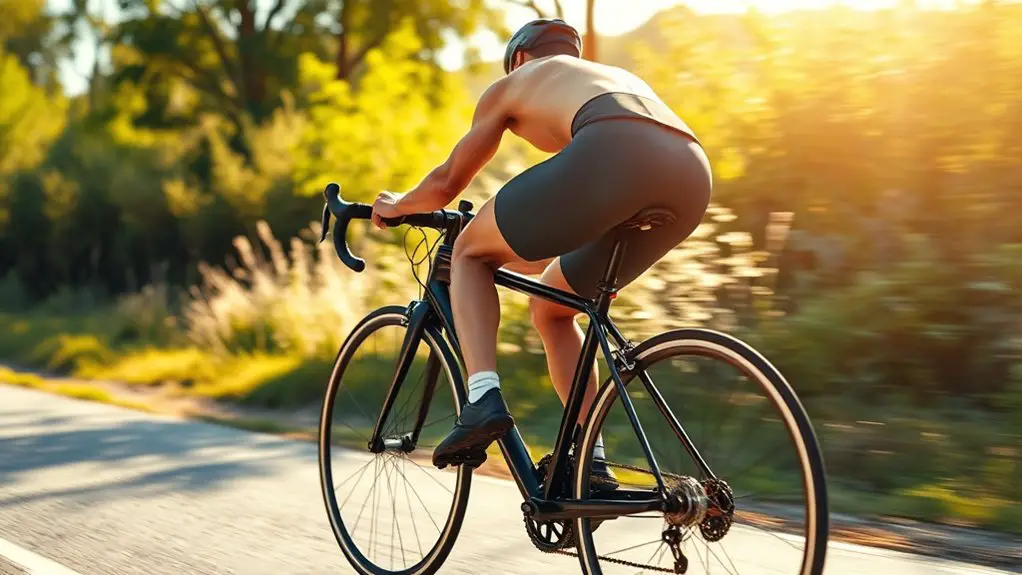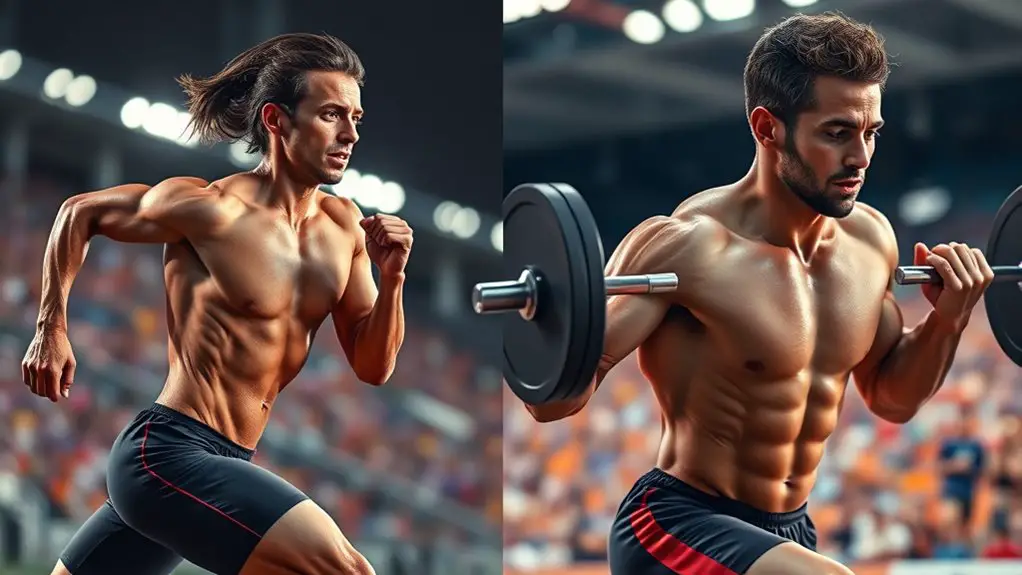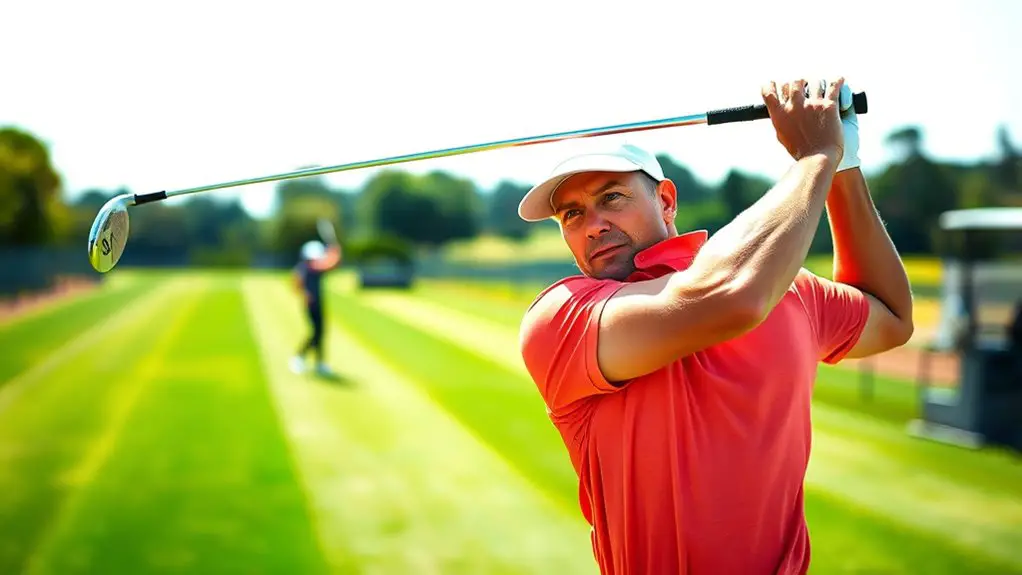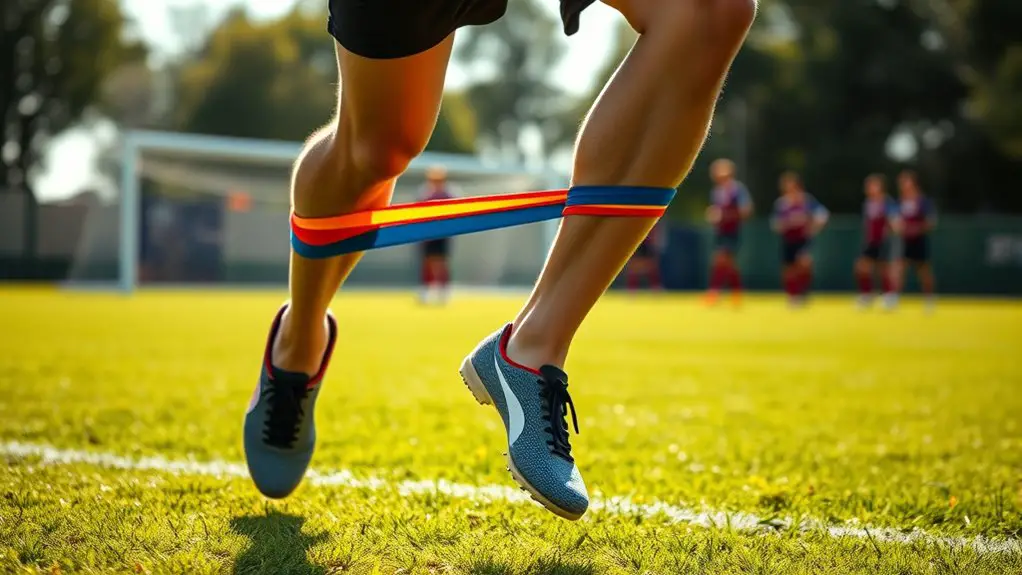The biomechanics of a perfect cycling posture involve maintaining proper body alignment, engaging your core, and adjusting your bike to fit you correctly. Focus on relaxed shoulders, a straight back, and slightly bent elbows to enhance comfort. Saddle height and position play a key role in your efficiency and power output. Engaging your core stabilizes your body, optimizing performance. By paying attention to these factors, you can improve your ride considerably. Discover more techniques to refine your cycling experience.
Understanding Cycling Biomechanics
When you hop on your bike, understanding cycling biomechanics can make a significant difference in your performance and comfort. By grasping the principles of pedal mechanics, you can optimize your energy output and enhance your riding experience. It's all about finding that sweet spot where your legs work efficiently, allowing you to conquer hills and coast freely on flat roads.
Cycling ergonomics plays an essential role in ensuring your body's alignment complements your pedaling style. Adjusting your seat height and handlebar position can help you maintain a natural posture, reducing strain and boosting performance. When you feel comfortable, you're more likely to enjoy the ride and seek new adventures.
The Importance of Proper Body Alignment
Proper body alignment is essential for a comfortable and efficient ride. When your spine is aligned and your joints are positioned correctly, you can maximize muscle engagement and reduce the risk of injury. Let's explore how these elements come together to enhance your cycling experience.
Spinal Alignment Essentials
Achieving ideal spinal alignment is essential for any cyclist looking to enhance performance and reduce the risk of injury. You'll want to focus on spinal curvature and utilize alignment techniques that promote proper posture. Start with a thorough posture assessment to identify areas needing improvement. Ergonomic adjustments to your bike, like lumbar support, can make a significant difference. Pay attention to thoracic alignment and cervical positioning to guarantee peak spinal mobility. A proper pelvic tilt can also help maintain balance and power transfer. Incorporating alignment exercises into your routine will strengthen your core and improve your overall cycling experience. Remember, a well-aligned spine not only enhances freedom on the bike but also keeps you riding pain-free.
Joint Positioning Impact
While many cyclists focus on their stamina and speed, the impact of joint positioning on performance and comfort shouldn't be overlooked. Proper alignment guarantees your body moves efficiently, enhancing both your cycling experience and endurance. Here's why joint angles and mobility matter:
- Optimal Joint Angles: Correct positioning keeps your joints aligned, reducing strain and preventing injuries.
- Enhanced Joint Mobility: Increased range of motion allows for smoother pedaling and better power transfer.
- Improved Comfort: A well-aligned body minimizes fatigue and enhances your ride, giving you the freedom to explore longer.
Muscle Engagement Strategies
When your body is aligned correctly on the bike, you can engage your muscles more effectively, leading to better performance and reduced fatigue. Proper body alignment facilitates peak muscle activation, allowing you to tap into your strength training gains while cycling. You'll feel that freedom in every pedal stroke, as your core and leg muscles work harmoniously to propel you forward. Without proper alignment, you risk overworking certain muscle groups, which can lead to fatigue and discomfort. Embrace the flow of your ride by focusing on maintaining a straight back, neutral pelvis, and relaxed shoulders. This alignment not only enhances your cycling experience but also increases endurance, making each ride more enjoyable and liberating.
Key Elements of Cycling Posture
To maintain an efficient and comfortable cycling posture, it's essential to focus on several key elements. These elements not only enhance your performance but also guarantee you enjoy the ride without discomfort. Remember to make ergonomic adjustments to your bike and refine your pedal technique. Here are three key elements to keep in mind:
- Core Engagement: A strong core stabilizes your body, allowing for better power transfer while cycling.
- Shoulder Relaxation: Keep your shoulders relaxed to prevent tension and maintain a fluid motion.
- Hand Position: Your hands should grip the handlebars lightly, promoting comfort and reducing fatigue. Staying properly hydrated before, during, and after cycling will further enhance your performance and support optimal energy levels.
The Role of Saddle Height and Position
Getting the right saddle height and position is essential for enhancing your cycling experience. When your saddle's set correctly, it allows for efficient pedaling, reducing fatigue and discomfort on long rides. You'll want to explore various saddle adjustment techniques to find what feels best for you.
Start by adjusting saddle height; your leg should have a slight bend at the bottom of the pedal stroke. Next, focus on ideal saddle positioning—forward or backward adjustments can dramatically influence your balance and power output.
Incorporating strength training into your routine can further improve your overall cycling posture and efficiency. Experimenting with these adjustments gives you the freedom to ride longer and stronger, enhancing your overall performance. Don't hesitate to make small tweaks during your rides to see how they impact your comfort and efficiency. Remember, finding that perfect fit can reveal new levels of enjoyment in your cycling journey!
Handlebars and Their Impact on Posture
Although you might not think about it often, the position of your handlebars plays an essential role in your overall cycling posture. Getting your handlebar height and grip width right can make a world of difference in comfort and performance.
Consider these key factors:
- Handlebar Height: A higher handlebar promotes a more upright position, reducing strain on your back.
- Grip Width: Wider grips can offer better stability, but too wide might limit your shoulder movement.
- Adjustability: Having adjustable handlebars lets you find that sweet spot for your riding style.
Finding your ideal setup doesn't just boost your efficiency; it also enhances your freedom on the bike. You should feel liberated, not restricted. So, take the time to tweak your handlebars and discover how it transforms your cycling experience. Your body will thank you!
Weight Distribution for Optimal Performance
As you ride, the way you distribute your weight on the bike can greatly affect your performance and comfort. A balanced weight shift helps you maintain control, allowing you to navigate curves and obstacles with ease. When you lean slightly forward, your center of gravity shifts, optimizing pedal pressure and enhancing your power output.
To achieve this, focus on keeping your hips aligned over the saddle while adjusting your torso position. If you lean too far back, you'll lose grip on the handlebars, compromising your stability. Conversely, too much forward weight can lead to discomfort in your arms and hands.
Finding that sweet spot means actively engaging with your bike, feeling how the weight shift impacts your ride. Embrace the freedom that comes from mastering your weight distribution, as it'll reveal your true potential on every adventure. Remember, it's all about that perfect balance! Additionally, ensuring proper mobility training will help maintain your joint health and improve your overall cycling performance.
Engaging Core Muscles for Stability
When you engage your core muscles, you not only enhance your stability but also improve your overall cycling performance. Core engagement is essential in maintaining a strong, balanced position on your bike. It allows you to ride longer and with more freedom, feeling the road beneath you.
Here are three key benefits of core engagement for cyclists:
- Improved Balance: A strong core helps you maintain control, especially on uneven terrain.
- Increased Power Transfer: Engaging your core guarantees energy flows efficiently from your legs to the pedals.
- Reduced Fatigue: Stability training through core engagement lessens the strain on your back and shoulders, keeping you fresh. A strong core also helps prevent injuries by stabilizing the spine and pelvis during intense cycling efforts.
Common Posture Mistakes to Avoid
When cycling, it's easy to make common posture mistakes that can affect your performance and comfort. Hunched shoulders, incorrect saddle height, and improper hand positioning can lead to discomfort or injury. Let's take a closer look at these pitfalls and how to avoid them. Proper warm-ups and stretching are crucial for preventing injuries that may arise from poor posture.
Hunched Shoulders and Neck
A relaxed riding position is essential for comfort and performance, yet many cyclists struggle with hunched shoulders and neck. This common mistake can lead to unnecessary neck tension and discomfort during your ride. To maintain a fluid and enjoyable cycling experience, keep these tips in mind:
- Engage your core: A strong core supports your upper body, reducing strain on your shoulders and neck.
- Adjust your handlebars: Make sure your handlebars are at a comfortable height to promote an open chest and relaxed shoulders.
- Practice good breathing: Deep, rhythmic breaths help alleviate tension and encourage a more natural posture.
Incorrect Saddle Height
Hunched shoulders and neck tension can often be exacerbated by incorrect saddle height. A proper saddle adjustment is essential for a comfortable ride, allowing you to enjoy the freedom of the open road without the strain. When your saddle's height measurement is off, it can lead to poor posture and discomfort.
| Saddle Height | Consequence |
|---|---|
| Too High | Knee pain, lower back strain |
| Too Low | Reduced power, leg fatigue |
| Correct | Ideal power transfer, comfort |
| Adjustable | Custom fitting for freedom |
| Regular Check | Guarantee ongoing comfort and efficiency |
Improper Hand Positioning
Proper hand positioning is essential for maintaining a comfortable and efficient cycling posture. When your hand grip and wrist alignment are off, it can lead to discomfort and reduced control. Here are some common mistakes to avoid:
- Overgripping the handlebars: This can cause tension in your arms and shoulders.
- Poor wrist alignment: Bending your wrists at awkward angles can lead to strain and numbness.
- Holding hands too far apart or close together: This can impact your balance and stability on the bike.
Finding that sweet spot in your hand positioning not only enhances your freedom while cycling but also allows you to ride longer and more enjoyably. So, tweak that hand grip and let your body flow with the ride!
Techniques for Maintaining Good Posture
Maintaining good posture while cycling is essential for both comfort and performance, especially on long rides. To keep your body aligned, start by incorporating posture cues into your routine. Focus on your back being straight, shoulders relaxed, and elbows slightly bent. This simple awareness can make a huge difference.
Next, use alignment drills to reinforce those cues. Before you hop on your bike, practice standing tall, engaging your core, and tilting your pelvis slightly forward. This helps create the foundation for a powerful cycling position.
As you ride, check in with yourself frequently. Adjust your grip and body position as needed, allowing for natural movement. If you're feeling fatigued, consider taking breaks to stretch and reset your posture. Remember, a few mindful adjustments can lead to a more enjoyable ride, letting you experience the freedom of cycling to the fullest. Additionally, incorporating mobility training into your routine can enhance your overall flexibility and reduce the risk of injury while cycling.
The Benefits of Professional Bike Fitting
When you invest in a professional bike fitting, you're setting yourself up for enhanced comfort and efficiency on every ride. This tailored approach can lead to improved performance metrics and help you avoid injuries down the line. Understanding these benefits can truly transform your cycling experience.
Enhanced Comfort and Efficiency
While many cyclists overlook the importance of bike fitting, investing in a professional fitting can greatly enhance your comfort and efficiency on the road. When you're comfortable, you can ride longer and enjoy every moment. Here are some benefits of a proper fit:
- Customized comfort adjustments: Eliminate hot spots and pressure points for a smoother ride.
- Enhanced efficiency techniques: Optimize your pedal stroke and energy use, ensuring every watt counts.
- Reduced fatigue: With the right posture, you'll minimize strain, allowing you to focus on the journey ahead.
Embrace the freedom of the open road with a bike that fits you perfectly. Your rides will transform, becoming more enjoyable and empowering than ever before. Invest in yourself; it's worth it!
Improved Performance Metrics
A proper bike fit not only enhances comfort but also plays a significant role in improving your overall performance metrics. When you're positioned correctly, you'll notice a boost in power output, allowing you to ride harder and longer without fatigue. This optimization translates into more efficient energy use, so you can enjoy the freedom of the open road without feeling drained. Plus, with a focus on cadence optimization, you'll find that maintaining your rhythm becomes effortless. This means you can tackle challenging terrains with ease, pushing your limits while staying in control. Ultimately, investing in a professional bike fitting can transform your cycling experience, revealing your true potential and making every ride feel liberating and powerful.
Injury Prevention Strategies
Proper bike fitting isn't just about comfort; it's an essential step in preventing injuries. When you're well-fitted to your bike, you can ride longer and freer, without the nagging pain that comes from poor posture. Here are a few benefits of professional bike fitting:
- Reduces strain on muscles and joints
- Enhances overall cycling efficiency
- Helps you perform rehabilitation exercises more effectively
Incorporating regular stretching routines into your cycling regimen can further enhance your flexibility and reduce the risk of injuries. A well-fitted bike allows you to achieve that perfect posture, so you can focus on the thrill of the ride. Remember, investing in a proper fit isn't just a luxury; it's a crucial part of your cycling journey.
Frequently Asked Questions
How Does Cycling Posture Affect Long-Term Joint Health?
Your cycling posture plays an essential role in long-term joint health. Proper joint alignment guarantees that your body moves efficiently, reducing strain on your joints. When you maintain the right posture, muscle engagement increases, supporting your joints and minimizing the risk of injury. If you want to ride freely and enjoyably, focusing on your posture can help you keep your joints healthy and functioning well for many years to come.
Can Posture Impact Breathing Efficiency While Cycling?
You might think it doesn't matter how you sit while cycling, but poor posture can really hinder your breathing mechanics. When your posture alignment's off, it can constrict your lungs, making it harder to take deep breaths. Imagine feeling free and powerful on your bike, with every breath fueling your ride. By maintaining proper posture, you'll enhance your breathing efficiency, allowing you to pedal longer and enjoy every moment on the road.
What Types of Injuries Are Linked to Poor Cycling Posture?
Poor cycling posture can lead to various injuries that might keep you from enjoying your rides. You could experience knee injuries due to improper alignment, causing strain on your joints. Additionally, back pain is common when your spine isn't properly supported, leading to discomfort on long rides. To maintain your freedom on the bike, it's essential to pay attention to your posture and make necessary adjustments to avoid these issues.
How Often Should I Adjust My Cycling Posture?
If you think you can ride forever without adjusting your cycling posture, think again! You should be making posture adjustments every 30-60 minutes during long rides. Cycling frequency can really take a toll on your body if you don't stay mindful. So, before you feel that familiar ache, give yourself a quick check. Your comfort and freedom on the bike depend on how well you maintain that perfect riding position!
Does Cycling Posture Differ Between Road and Mountain Biking?
Absolutely, cycling posture varies between road and mountain biking. On a road bike, you'll typically lean forward, optimizing aerodynamics for speed. Your back's more horizontal, letting you slice through the wind. In contrast, mountain biking requires a more upright stance, giving you better control over rough terrain. You'll need to shift your weight back on descents and forward on climbs. Each posture complements the unique demands of the ride, letting you embrace the freedom of both styles!




